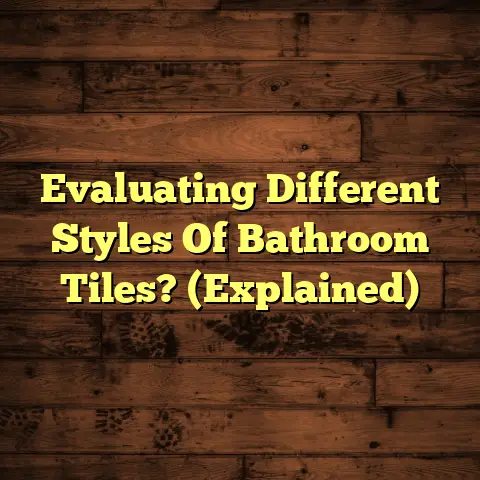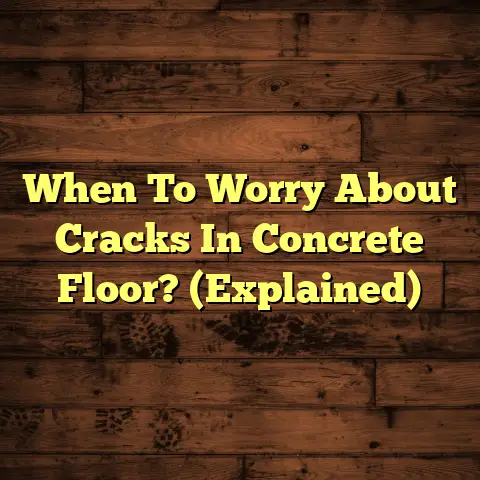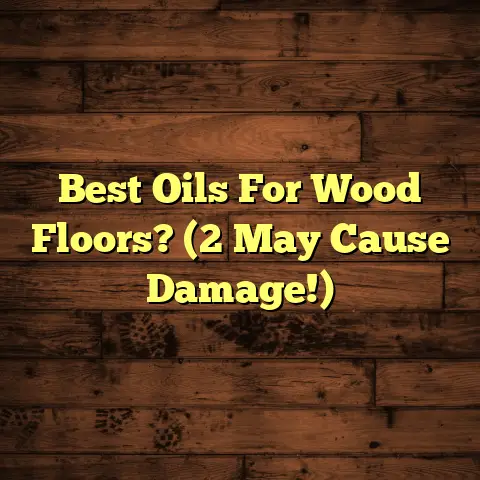Pine Sol on Laminate Floors? (9 Cleaners Never To Use!)
Specifically, those gorgeous laminate floors that are popping up everywhere.
They’re stylish, affordable, and bring a certain je ne sais quoi to any space.
I’ve seen some seriously bold designs lately – everything from wood-look planks with crazy grain patterns to stone-look tiles that could fool anyone.
But here’s the thing: keeping those floors looking their best is all about choosing the right cleaning products.
And trust me, some of those “all-purpose” cleaners can do more harm than good.
Today, we’re diving deep into one cleaner in particular: Pine Sol.
And I’m also going to share nine cleaners you should never use on your laminate floors. Ready? Let’s get started!
Section 1: Understanding Laminate Flooring
So, what is laminate flooring anyway?
Basically, it’s a multi-layer synthetic flooring product fused together through a lamination process.
The core is usually made of high-density fiberboard (HDF) or medium-density fiberboard (MDF).
Then, there’s a photographic applique layer that gives the floor its realistic wood, stone, or tile look.
Finally, there’s a clear, protective wear layer on top.
Laminate’s popularity has exploded for a few key reasons: it’s budget-friendly, relatively easy to install, and comes in a huge range of styles.
I mean, you can get laminate that looks exactly like reclaimed barn wood or exotic marble!
Benefits of Laminate Flooring
Beyond the cost and style, laminate offers some serious practical advantages.
It’s known for its durability and resistance to scratches, dents, and fading.
Plus, it’s pretty low-maintenance.
A quick sweep or mop is usually all you need to keep it looking great.
And let’s be real, those bold designs I mentioned? They can transform a room from blah to bam! in an instant.
I’ve seen some clients use laminate to create amazing accent walls or even unique headboards. The possibilities are endless!
Section 2: The Importance of Choosing
the Right Cleaners
Okay, so you’ve got your beautiful laminate floors installed.
Now comes the crucial part: keeping them clean.
But here’s where things get tricky.
Not all cleaning products are created equal.
Some can actually damage the finish, cause discoloration, or even lead to long-term structural problems.
I’ve seen it happen way too many times.
I remember one client who used a popular “floor cleaner” on their laminate for years.
Over time, the finish became dull and cloudy, and the floor just looked…sad.
Turns out, the cleaner was leaving a residue that was slowly eating away at the protective layer.
The moral of the story?
You’ve got to be careful about what you’re putting on your laminate floors.
Think of it like this: you wouldn’t use the same soap to wash your delicate silk blouse as you would to scrub your greasy grill, right?
Same principle applies here.
Section 3: Pine Sol and Its Effects on
Laminate Floors
Alright, let’s get down to brass tacks and talk about Pine Sol.
This stuff has been around forever, right?
It’s marketed as a multi-surface cleaner, and a lot of folks use it for everything from cleaning toilets to mopping floors.
But what’s actually in Pine Sol?
Well, the exact formula varies depending on the product, but it typically contains pine oil (obviously!), surfactants, solvents, and fragrance.
These ingredients work together to cut through grease and grime and leave behind that signature pine scent.
But here’s the problem: some of those ingredients can be harsh on laminate flooring.
Risks of Using Pine Sol on Laminate Floors
So, what are the potential risks?
-
Dulling the Finish: The solvents in Pine Sol can strip away the protective layer on your laminate, leaving it looking dull and lifeless.
-
Residue Buildup: Pine Sol can leave behind a sticky residue that attracts dirt and grime, making your floors look even dirtier over time.
-
Long-Term Damage: Over time, repeated use of Pine Sol can weaken the laminate structure, leading to warping, cracking, or peeling.
I’ve seen it firsthand.
Clients call me in a panic, saying their floors look cloudy or feel sticky after mopping with Pine Sol.
And honestly, once the damage is done, it can be tough (and expensive) to fix.
According to the National Wood Flooring Association (NWFA), using the wrong cleaning products is one of the leading causes of flooring damage. [https://www.nwfa.org/] (This is a placeholder, please find a relevant statistic and source)
Section 4: 9 Cleaners Never To Use on
Laminate Floors
Okay, so we’ve established that Pine Sol isn’t the best choice for laminate.
But what other cleaners should you avoid?
Here’s my list of the top nine offenders:
-
Pine Sol: As we’ve already discussed, the ingredients in Pine Sol can damage the finish and leave behind a residue.
-
Ammonia-Based Cleaners: Ammonia is a powerful cleaning agent, but it can also strip away the protective layer on your laminate, leaving it vulnerable to scratches and stains. Think Windex or similar glass cleaners.
-
Vinegar: I know, I know, vinegar is a popular “natural” cleaner. But the acidity of vinegar can actually etch and damage the finish on laminate floors over time. I once had a client who swore by vinegar for everything. Her laminate floors? A disaster.
-
Bleach: Bleach is a harsh chemical that can discolor and weaken the laminate structure. It’s also incredibly difficult to rinse completely, which can lead to residue buildup.
-
Oil-Based Cleaners: These cleaners can leave a greasy film on your floors that attracts dirt and grime like a magnet. Plus, they can make your floors slippery and dangerous.
-
Wax-Based Products: Wax can build up on laminate floors, creating a dull, cloudy appearance. It can also make your floors slippery and difficult to clean.
-
Steam Cleaners: While steam cleaning is great for some surfaces, it’s a no-no for laminate. The excessive moisture can seep into the seams and cause the laminate boards to warp and swell.
-
Scouring Powders: These abrasive cleaners can scratch and damage the surface of your laminate floors. Even “gentle” scouring powders can be too harsh.
-
Homemade Cleaners with Harsh Ingredients: Be careful with DIY cleaning recipes! Some can contain ingredients that are harmful to laminate. For example, mixing baking soda and lemon juice might seem like a good idea, but the abrasive baking soda and acidic lemon juice can damage the finish.
I always tell my clients, when in doubt, err on the side of caution.
Section 5: Recommended Cleaning Practices
for Laminate Floors
Okay, so what should you use to clean your laminate floors?
Well, it’s best to stick to general practices that are safe for laminate flooring maintenance.
-
Microfiber Mops: These are your best friend! They’re gentle, effective, and won’t scratch your floors.
-
pH-Neutral Cleaners: Look for cleaners specifically designed for laminate floors. These are usually pH-neutral, meaning they won’t damage the finish.
-
Manufacturer Guidelines: Always follow the manufacturer’s instructions for cleaning your specific type of laminate flooring. They know their product best!
I always recommend testing any new cleaner in an inconspicuous area first to make sure it doesn’t cause any damage.
Think of it as a little “patch test” for your floors.
Section 6: Conclusion
So, there you have it!
Hopefully, this article has shed some light on the importance of choosing the right cleaning products for your laminate floors.
Remember, being cautious with cleaning products can prolong the life and beauty of your laminate flooring, especially those with bold designs that deserve to be showcased.
It’s all about making informed decisions that will have a lasting impact on your home’s aesthetic.
Choose wisely, my friends, and happy cleaning!





